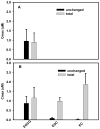Pharmacokinetic and chemoprevention studies on tea in humans
- PMID: 21624470
- PMCID: PMC3152306
- DOI: 10.1016/j.phrs.2011.05.007
Pharmacokinetic and chemoprevention studies on tea in humans
Abstract
Green tea and its major polyphenols constituents, tea catechins, have been shown to have many health benefits including cancer prevention. Tea catechins and tea catechin metabolites/catabolites are bioavailable in the systemic circulation after oral intake of green tea or green tea catechins. The metabolites/catabolites identified in humans include glucuronide/sulfate conjugates, methylated tea catechin conjugates, and microflora-mediated ring fission products and phenolic acid catabolites. Plasma levels of unchanged tea catechins in humans are mostly in the sub-μM or nM concentration range, which is much lower than the effective concentrations determined in most in vitro studies. However, some of the catechin metabolites/catabolites are present in the systemic circulation at levels much higher than those of the parent catechins. The contribution of catechin derived metabolites/catabolites to the biological effects associated with green tea is yet to be defined. A limited number of chemoprevention trials of green tea or green tea catechins have been conducted to date and have observed potential preventive activity for oral, prostate, and colorectal cancer. Emerging data from multiple ongoing intervention trials will further contribute to defining the cancer preventive activity of green tea or green tea catechins.
Copyright © 2011 Elsevier Ltd. All rights reserved.
Figures



References
-
- Katiyar SK, Mukhtar H. Tea consumption and cancer. World Review of Nutrition & Dietetics. 1996;79 :154–184. - PubMed
-
- Yang CS, Wang X. Green tea and cancer prevention. Nutr Cancer. 2010;62(7):931–937. - PubMed
-
- Rains TM, Agarwal S, Maki KC. Antiobesity effects of green tea catechins: a mechanistic review. J Nutr Biochem. 2011;22(1):1–7. - PubMed
-
- Cooper R, Morre DJ, Morre DM. Medicinal benefits of green tea: Part I. Review of noncancer health benefits. Journal of Alternative & Complementary Medicine. 2005;11(3):521–528. - PubMed
Publication types
MeSH terms
Substances
Grants and funding
LinkOut - more resources
Full Text Sources

